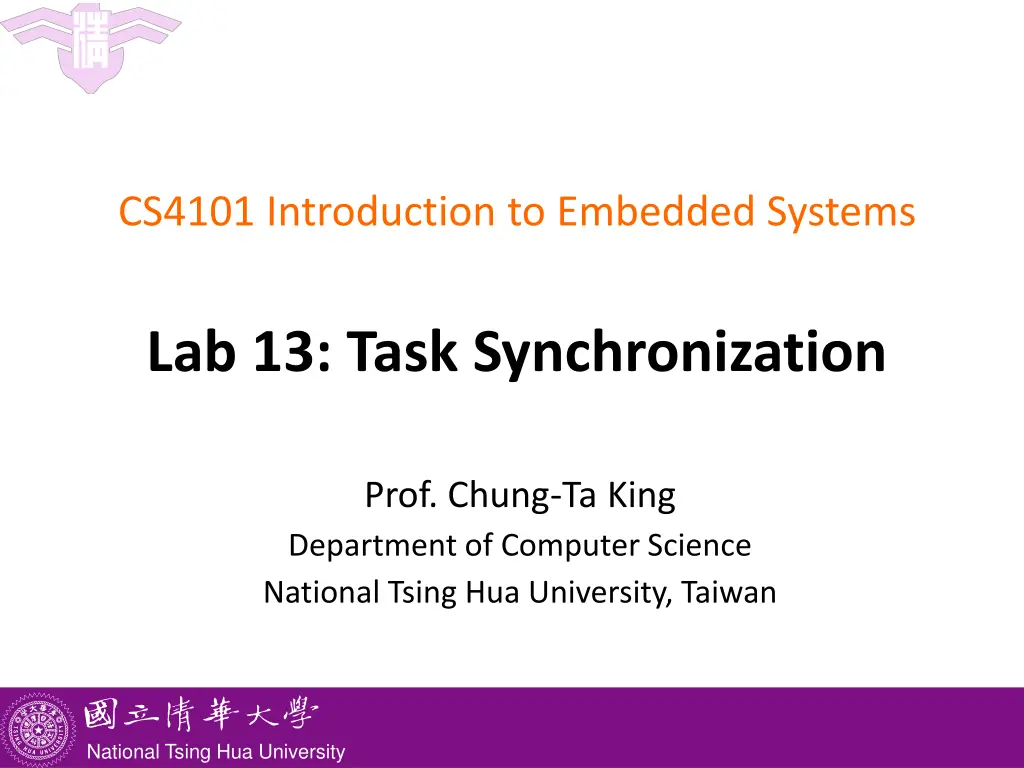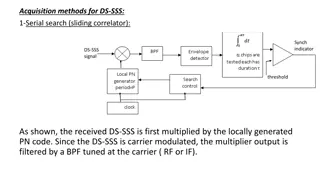
Task Synchronization in Embedded Systems Lab 13
Learn about task synchronization using synchronization primitives in this lab at National Tsing Hua University. Explore sample code for reader-writer tasks, managing buffers, writer and reader task coordination, and a main code snippet. Get insights into synchronization techniques and task coordination for embedded systems.
Uploaded on | 0 Views
Download Presentation

Please find below an Image/Link to download the presentation.
The content on the website is provided AS IS for your information and personal use only. It may not be sold, licensed, or shared on other websites without obtaining consent from the author. If you encounter any issues during the download, it is possible that the publisher has removed the file from their server.
You are allowed to download the files provided on this website for personal or commercial use, subject to the condition that they are used lawfully. All files are the property of their respective owners.
The content on the website is provided AS IS for your information and personal use only. It may not be sold, licensed, or shared on other websites without obtaining consent from the author.
E N D
Presentation Transcript
CS4101 Introduction to Embedded Systems Lab 13: Task Synchronization Prof. Chung-Ta King Department of Computer Science National Tsing Hua University, Taiwan National Tsing Hua University
Introduction In this lab, we will learn To synchronize tasks using synchronization primitives of MQX 1 National Tsing Hua University
Sample Code: Reader-Writer NUM_BUFFERS buffers NUM_WRITERS writer tasks: Read data from 3-axis accelerometer Fill the first empty buffer with the received data 1 reader task: Find the first filled buffer and empty it Synchronization among writers and reader: each buffer is given three flags Assigned = 1: buffer is assigned to a writer task for writing Filled = 1: buffer is filled with data and is ready for read Emptied = 1: buffer is empty and is ready for write 2 National Tsing Hua University
Tasks and Buffers k writer tasks (read 3-axis data) Suppose k > n semaphore (count = n) Flags of buffers: Assigned Filled Emptied n buffers 1 reader task 3 National Tsing Hua University
Writer and Reader Task Writer task: Read data from 3-axis accelerometer Find the first unassigned buffer and mark it assigned Wait until the buffer is empty and mark it not emptied Fill the buffer with data Mark the buffer filled and unassigned Reader task: Find the first filled buffer and mark it not filled Read the data from the buffer Mark the buffer emptied Semaphore index_sem to control at most NUM_BUFFERS writer tasks in filling the buffers 4 National Tsing Hua University
Sample Code: Main #include <mqx.h> #include <bsp.h> #include <sem.h> #include <fio.h> uchar buffer[NUM_BUFFERS][ARRAY_SIZE]; int Assigned[NUM_BUFFERS]; int Filled[NUM_BUFFERS]; int Emptied[NUM_BUFFERS]; const TASK_TEMPLATE_STRUCT MQX_template_list[] = { { MAIN_TASK, main_task, 2000, 8, "main", MQX_AUTO_START_TASK, 0, 0 }, { WRITE_TASK, write_task, 2000, 8, "write", MQX_TIME_SLICE_TASK, 0, 10 }, { READ_TASK, read_task, 2000, 8, "read", MQX_TIME_SLICE_TASK, 0, 10 }, { 0 } }; 5 National Tsing Hua University
Sample Code: Main void main_task(uint_32 initial_data) { _task_id task_id; /* Initialize the flags */ for (i = 0; i < NUM_BUFFERS; i++) { Assigned[i] = 0; Filled[i] = 0; Emptied[i] = 1; } /* Create the semaphores */ if(_sem_create_component(1,1,6) != MQX_OK) { ... } if(_sem_create("sem.index",NUM_BUFFERS,0)!= MQX_OK){} /* Create the tasks */ for (i = 0; i < NUM_WRITERS; i++) { task_id = _task_create(0, WRITE_TASK, (uint_32)i);} task_id = _task_create(0,READ_TASK, 0); _task_block(); } 6 National Tsing Hua University
Sample Code: Writer void void write_task(uint_32 initial_data){ pointer index_sem; if(_sem_open("sem.index",&index_sem) != MQX_OK) {...} while (TRUE) { if(_sem_wait(index_sem, 0) != MQX_OK) {...} for(i = 0; i < NUM_BUFFERS; i++){ if(Assigned[i] == 0) { Assigned[i] = 1; while(Emptied[i] == 0){ ... /* wait */ } Emptied[i] = 0; for(j = 0; j < ARRAY_SIZE; j++){ buffer[i][j] = ... /* fill the buffer */ } Assigned[i] = 0; Filled[i] = 1; break;} } _sem_post(index_sem); } } CS 7 National Tsing Hua University
Sample Code: Reader void read_task(uint_32 initial_data) { pointer index_sem; int i; while (TRUE) { for(i = 0; i < NUM_BUFFERS; i++){ if(Filled[i] == 1){ Filled[i] = 0; ... /* read and empty the buffer */ Emptied[i] = 1; break; } } } } 8 National Tsing Hua University
Semaphores & RoundRobin: user_config.h 1. Add the definition in bsp_twrk60d100m/twrk60d100m/user_config.h #define MQX_USE_SEMAPHORES 1 #define MQX_HAS_TIME_SLICE 1 2 2. Rebuild the bsp and psp library 1 2 9 National Tsing Hua University
Basic Lab There is a race condition in the sample code. Use semaphores or mutex to protect the critical data structures. [Hint]: First check whether there is a race condition between writer and reader tasks by examining their common variables. Next, do the same between writer tasks. Modify the writer code to minimize the time spend in the critical section, i.e., move all non-critical operations out of the critical section. 10 National Tsing Hua University
Bonus Lab In the original sample code, the writer task, after grabbing a buffer by finding the first unassigned buffer, waits for Emptied[i] == 1 using a while-loop. This is basically a spin-wait, which wastes CPU. Use Events to let the task blocked wait. 11 National Tsing Hua University


